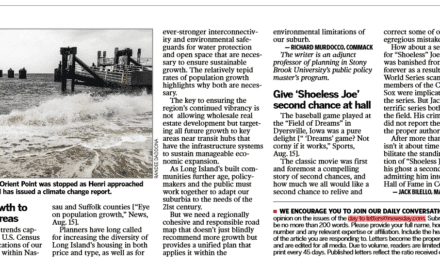The backlash continues regarding a letter Suffolk County Legislator Barraga sent to Matthew Cutrone, a constituent whose mother was hit by a van and injured while biking in Babylon Village. Matthew wrote the legislator regarding biking in Suffolk County, and the legislator responded personally. What happened to the Cutrone family is a sad story, and shows that drivers need to respect the rules of the road while keeping an eye out for bikers.
However, the story also highlights a fact-
Suffolk County is NOT biker friendly.
This isn’t out of bias, discrimination or purposeful exclusion, but rather, the byproduct of the County’s existing, physical suburban form.
The legislator’s response letter went viral, sending what I call “armchair planners” up in arms over the honest response, casting their judgment from the ivory tower of which they are so fond of. These are the same types of planners who put traffic circles where they don’t belong, try to plug the brain drain with density without thinking bigger picture, and place ideology over sound planning principles.
Despite the fervor by transit advocates, statistics show that roads in both Nassau and Suffolk Counties weren’t exactly friendly towards bicyclists. As reported by Newsday,:
“In 2012, the last year with available statistics, 388 bicyclists were injured in crashes with vehicles in Suffolk and the same amount were hurt in Nassau County, according to the state Department of Motor Vehicles. There were seven bicyclists killed in crashes with vehicles in Suffolk in 2012 and three in Nassau, according to the DMV statistics.”
Legislator Barraga’s assessment was honest, which some would argue was refreshing to see from a politician, while others found the answer cold. Whether we want to hear it or not, the reality we have to understand is that Suffolk County’s roads are not friendly towards bicycling. You’d be hard pressed to find an older suburban area similar to Suffolk that is.
Safety is the By-Product of Design
Suffolk’s roads are not safe for bicyclist traffic because of their auto-centric design. They simply weren’t built for bikes. In planning, there is an offshoot to the previously discussed conflict of land use that focuses on incompatible traffic types. A notable example would be bicyclists using Sunrise Highway for their local traffic needs. The express nature of vehicular traffic on the route paired with bicycles traveling locally is a recipe for disaster, resulting in a direct conflict of usage. This notion rings true on Suffolk’s roads thanks in part to the decades-worth of sprawl.
Even the installation of bike lanes and expansion of associated infrastructure doesn’t fully solve the safety problem because drivers often don’t respect the lanes. Looking west towards NYC, you can see how residents often push against bike lane expansions in various neighborhoods, arguing that auto traffic flow suffers, as well does pedestrian safety . Whether the city residents are correct to protest or not, bicyclist traffic is having a hard time assimilating into Manhattan and the boroughs, which are some of the densest places on earth. How can we expect a smooth transition out in the suburbs, where things are much more spread out, and the culture is decidedly auto-centric?
A Dangerous Reality
As much as we want “downtown” style living, complete with dense population centers that are walkable, we must remember our region’s limitations. Just because we say something should be, doesn’t mean it immediately is. For the most part, Suffolk’s sprawling nature does not safely accommodate biking. Unless there is a fundamental physical shift in the County’s form, as well as a large change in cultural mindset, it will remain that way.
Sometimes we have to take Suffolk for what it is, (in this instance, an auto-centric suburb) and work out from there. The danger of putting ideology first over the existing reality in planning can result in a large conflict of usage, which is a serious safety problem for all involved.
We can strive towards an ideal, but not while ignoring a dangerous reality.











